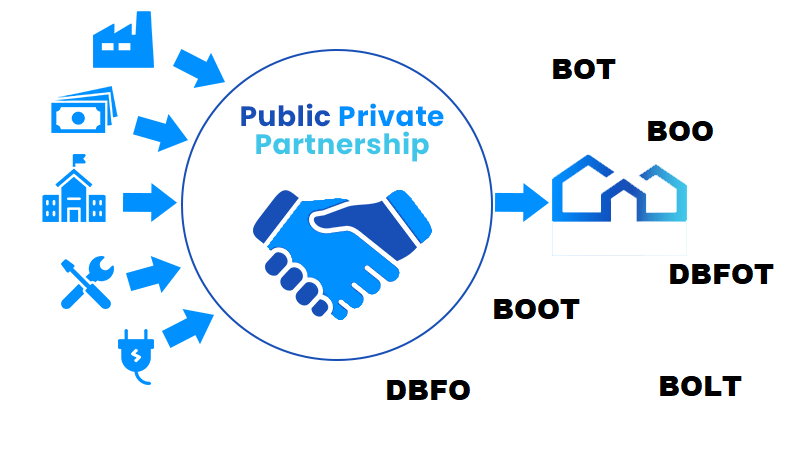
Public-private partnerships (PPP) are contractual arrangements between a public sector entity (such as a government agency) and a private sector entity (such as a corporation) to provide a public service or infrastructure project. PPP (public private partnership) using various partnership model (BOT, BOO, BOLT) is to facilitate easy access of capital for infrastructure projects. One of the tools of PPP is VGF (viability gap financing) which had high return but high risk as well. New financing resources need to be developed not only on the debt side but also on the equity side.
There are several partnership models of PPP, including:
- Build-Operate-Transfer (BOT): Under the BOT model, a private sector entity is responsible for financing, designing, constructing, and operating a public service or infrastructure project for a specified period. At the end of the concession period, the private sector entity transfers the ownership of the project to the public sector entity.
- It is conventional PPP model in which private partner is responsible to design, build, operate (during the contracted period) and transfer back the facility to the public sector.
- •Private sector partner has to bring the finance for the project and take the responsibility to construct and maintain it.
- •Public sector will allow private sector partner to collect revenue from the users.
- The national highway projects contracted out by NHAI under PPP mode is a major example for the BOT model.
- Design-Build-Operate (DBO): Under the DBO model, a private sector entity is responsible for financing, designing, constructing, and operating a public service or infrastructure project for a specified period. The private sector entity owns the project during the concession period and transfers the ownership to the public sector entity at the end of the period.
- Build-Own-Operate-Transfer (BOOT): Under the BOOT model, a private sector entity is responsible for financing, designing, constructing, and operating a public service or infrastructure project for a specified period. The private sector entity owns the project during the concession period and transfers the ownership to the public sector entity at the end of the period.
- In this variant of BOT, after the negotiated period of time, project is Transferred to the government or to the private operator.
- BOOT model is used for the development of highways and ports.
- Build-Transfer-Operate (BTO): Under the BTO model, a private sector entity is responsible for financing, designing, and constructing a public service or infrastructure project, and transfers the ownership of the project to the public sector entity at the end of the construction period. The private sector entity may also operate the project for a specified period.
- BOO: In this model ownership of the newly built facility will rest with the private party. •On mutually agreed terms and conditions public sector partner agrees to ‘purchase’ the goods and services produced by the project.
- BOLT: In this approach, the government gives a concession to a private entity to build a facility (and possibly design it as well), own the facility, lease the facility to the public sector and then at the end of the lease period transfer the ownership of the facility to the government. This approach has been used for the development of highways and ports.
- DBFO: In this model, entire responsibility for the design, construction, finance, and operation of the project for the period of concession lies with the private party.
- Operate-Maintain-Transfer (OMT): Under the OMT model, a private sector entity is responsible for operating and maintaining a public service or infrastructure project for a specified period, and then transfers the ownership of the project to the public sector entity at the end of the concession period.
- LDO: In this type of investment model either the government or the public sector entity retains ownership of the newly created infrastructure facility and receives payments in terms of a lease agreement with the private promoter. •It is mostly followed in the development of airport facilities.
- Management contract: Here, the private promoter has the responsibility for a full range of investment, operation and maintenance functions. He has the authority to make daily management decisions under a profit-sharing or fixed-fee arrangement.
- Service contract: This approach is less focused than the management contract. In this approach, the private promoter performs a particular operational or maintenance function for a fee over a specified period of time.
Each partnership model has its own advantages and disadvantages, and the appropriate model to use will depend on the specific needs and circumstances of the project. It is important for both public and private entities to carefully consider the benefits and risks associated with each model before entering into a PPP
Register & Download PDF for Educational Purposes Only
Project Planning and Management Study notes for M. plan Sem-II

project planning and management.pdf
Register as member and login to download attachment [pdf] by right-click the pdf link and Select “Save link as” use for Educational Purposes Only
Disclaimer
Information on this site is purely for education purpose. The materials used and displayed on the Sites, including text, photographs, graphics, illustrations and artwork, video, music and sound, and names, logos, IS Codes, are copyrighted items of respective owners. Front Desk is not responsible and liable for information shared above.